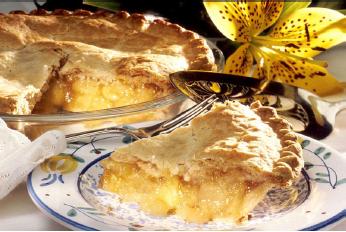Description
 My birthday is coming up and traditionally I'm serving pie. Not just one pie, no, I have a number N of them, of various tastes and of various sizes. F of my friends are coming to my party and each of them gets a piece of pie. This should be one piece of one pie, not several small pieces since that looks messy. This piece can be one whole pie though.
My birthday is coming up and traditionally I'm serving pie. Not just one pie, no, I have a number N of them, of various tastes and of various sizes. F of my friends are coming to my party and each of them gets a piece of pie. This should be one piece of one pie, not several small pieces since that looks messy. This piece can be one whole pie though. My friends are very annoying and if one of them gets a bigger piece than the others, they start complaining. Therefore all of them should get equally sized (but not necessarily equally shaped) pieces, even if this leads to some pie getting spoiled (which is better than spoiling the party). Of course, I want a piece of pie for myself too, and that piece should also be of the same size.
What is the largest possible piece size all of us can get? All the pies are cylindrical in shape and they all have the same height 1, but the radii of the pies can be different.
Input
- One line with two integers N and F with 1 ≤ N, F ≤ 10 000: the number of pies and the number of friends.
- One line with N integers ri with 1 ≤ ri ≤ 10 000: the radii of the pies.
Output
标准的二分,注意精度,
首先用mid去判断,每个蛋糕切分后,每一份为mid,最多切分(int)(area/mid)份,这是一份蛋糕的,那么所有的就是求和,然后再和F+1(注意是F+1,自己也要的啊)
比较,如果大于等于F+1,那么说明每人拿mid是可以的,答案或许会更大,
如果小于F+1,那么说明mid太大了,这就是二分的细节了
#include<stdio.h>
#include<math.h>
const double PI=acos(-1.0);
double area[10010];//蛋糕面积
int F,n;
bool judge(double each_area)
{
int seg=0;
for(int i=0;i<n;i++)
seg+=(int)(area[i]/each_area);//把每块蛋糕可以分成的份数相加,注意
return seg>=F+1;//别忘了自己
}
void huafeng(double low,double high)
{
double mid;
while(high-low>1e-6)
{
mid=(low+high)/2;
if(judge(mid))
low=mid;
else
high=mid;
}
printf("%.4f\n",mid);
}
int main()
{
int t;
while(~scanf("%d",&t))
{
while(t--)
{
scanf("%d%d",&n,&F);
int r;
double max=-1;
for(int i=0;i<n;i++)
{
scanf("%d",&r);
area[i]=(PI*r*r);
if(area[i]>max)
max=area[i];
}
huafeng(0,max);//每个人最多拿到的蛋糕不会大于面积最大的蛋糕,所以 //可以做上限
}
}
return 0;
}





 本文介绍了一个经典的二分查找算法案例——如何将多个不同大小的圆形蛋糕公平地分给一定数量的人,确保每个人都能得到体积相同的一块蛋糕。通过计算每个蛋糕的最大可能体积,使得分配过程既公平又高效。
本文介绍了一个经典的二分查找算法案例——如何将多个不同大小的圆形蛋糕公平地分给一定数量的人,确保每个人都能得到体积相同的一块蛋糕。通过计算每个蛋糕的最大可能体积,使得分配过程既公平又高效。
















 139
139

 被折叠的 条评论
为什么被折叠?
被折叠的 条评论
为什么被折叠?








